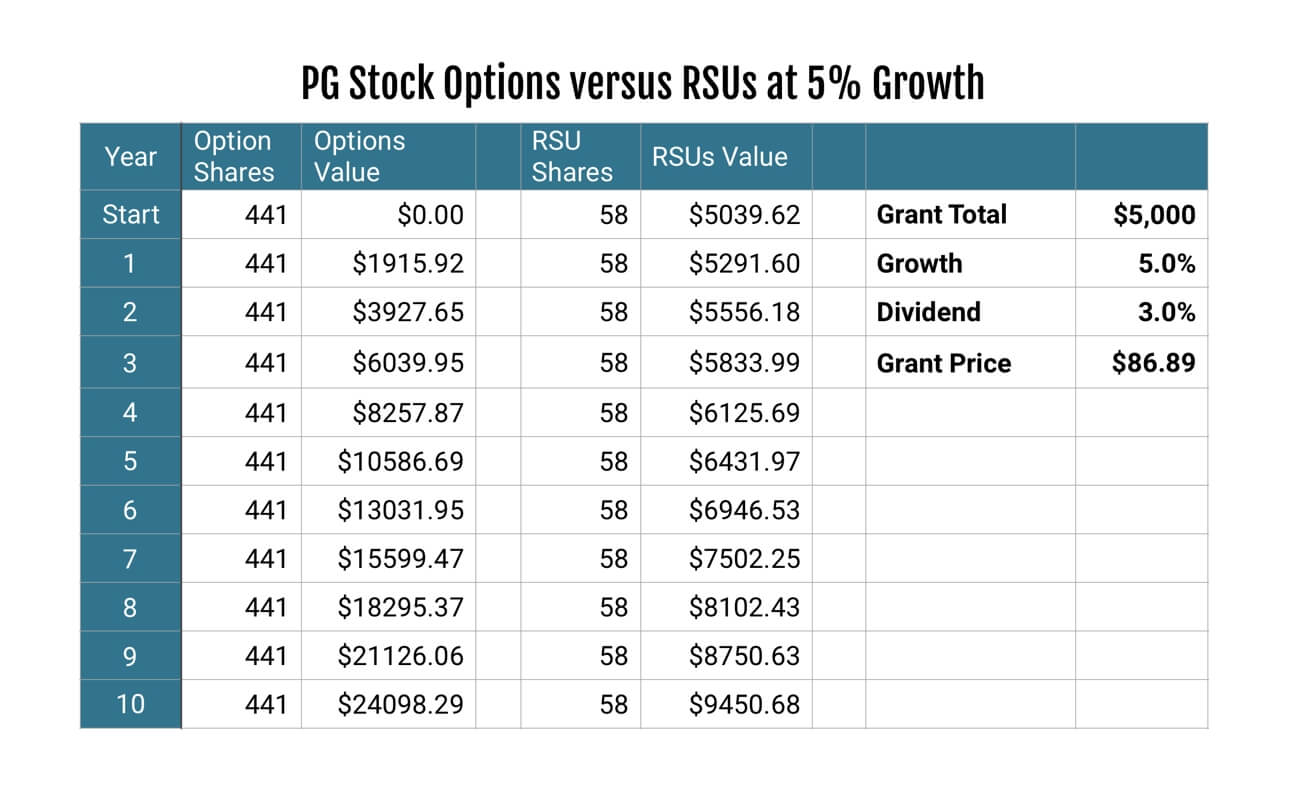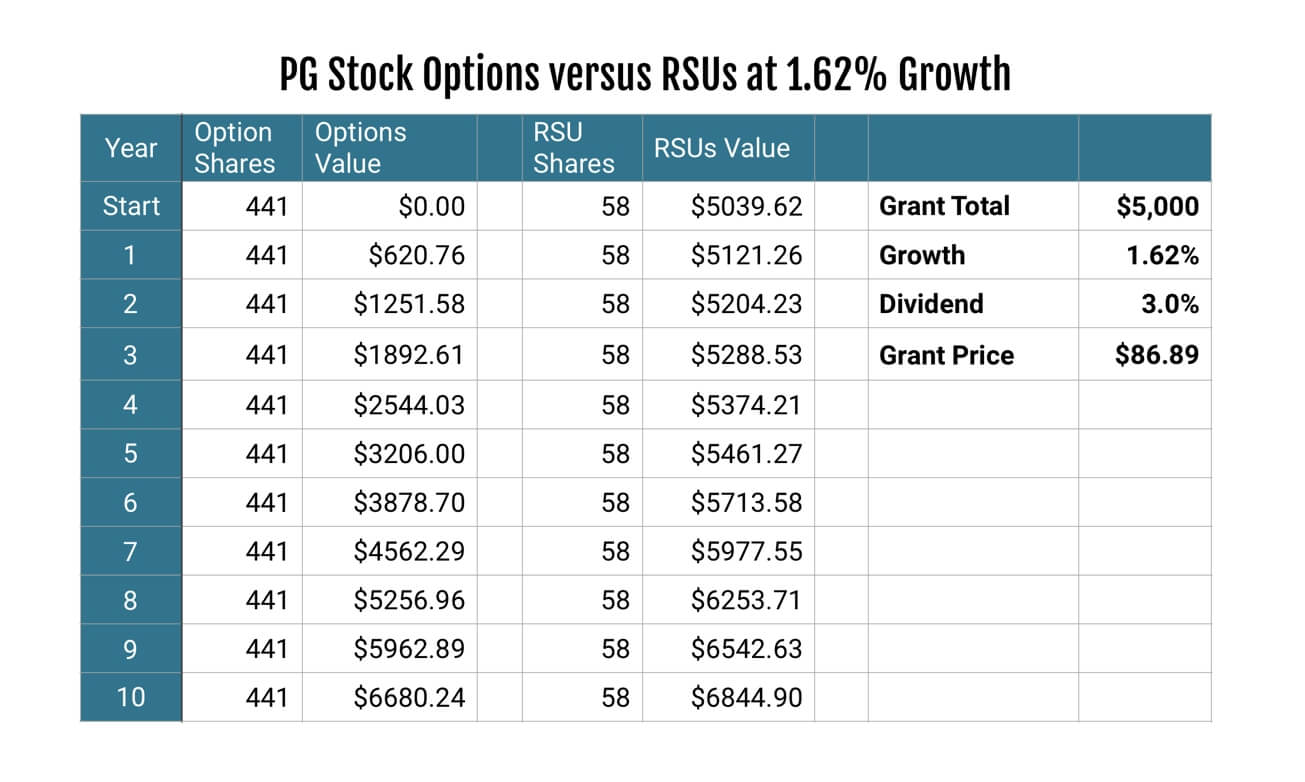Updated for 2018
You need to consider two criteria when deciding whether to take your Long-Term Incentive Program LTIP awards as stock options or as Restricted Stock Units (RSUs).
- If you need to time future incomes for tax planning purposes
- The growth potential you believe that the company stock has over the next ten years.
Up through 2016, there was a third criterion based on how long you intended to stay with the company. Starting in 2017, both RSUs and stock options have a three year vesting period which essentially removed the need to consider this when making your decision.
Couple quick definitions
Stock Options give you the right, but not the obligation, to purchase shares of Procter and Gamble stock at a predetermined price at a future date. You do not receive dividends on stock options until you exercise the options.
Restricted Stock Units (RSUs) are grants of stock given to employees with restrictions such as no voting rights. They convert to common stock plus accumulated dividends after a three year vesting period.
RSUs granted before 2017 do not pay dividends until after the five year vesting period.
Future Income Planning for Tax Purposes
Stock options vest after three years and expire after ten years. If you choose to take your LTIP award as stock options, you can execute the options at anytime after the third year and before the tenth year. This gives you quite a bit of flexibility over when to accept the taxable income.
RSUs vest and expire exactly three years after the grant has been made. You have no control over when to take the income.
In both cases, the day you exercise the stock options or the day the RSUs vest, the resulting income is fully taxable as employment income. This means that the income is subject to ordinary federal income tax, state and local income tax and social security and medicare income taxes.
Future Growth of Procter & Gamble
The final criterion is based on your belief on how much Procter & Gamble stock will grow over the next three to ten years. To make this determination, you need to separate the stock price growth from the dividends paid by the stock. Stock options do not earn dividends before they are exercised.
The comparison between stock options and RSUs should be made over a ten-year period. The stock options have a ten-year life from the date of grant and allow the stock growth to be leveraged over those ten years. To make the comparison accurate, we will include dividends on the RSUs. We will also assume that earned dividends are reinvested for the entire ten years.
In Procter & Gamble’s 2017/2018 example, they use November 1, 2017, price of PG stock of $86.89 and stock option cost of $11.34. This results in a $5,000 award of either 58 RSUs or 441 stock options. Of course, the price of the stock can, and will change between now and February 2018 when the award is granted. Still, these are good numbers to use for our example.
If PG stock grows at 5%
The following table shows how a $5,000 award could grow at a 5% growth rate and a 3% dividend rate.

After only three years, the stock options have caught up to the RSUs in value, and after ten years the stock options are worth 2.5 times the value of the RSUs.
If PG stock only does as well as the last ten years
What if Procter & Gamble has a dismal decade similar to the prior ten years? November 1, 2007, PG stock opened at $74. As of November 1, 2017, the price was $86.89. That is a mere 1.62% growth rate over the last ten years. (Keep in mind we are not taking dividends into account because we don’t receive them on stock options.)

As you can see from the table above, if Procter & Gamble stock grows at a 1.62% rate while continuing a 3% dividend, the choice between the stock options and the RSUs is pretty much equal. However, if the stock grows at a higher rate, the stock options will outperform the RSUs.
Of course, if Procter & Gamble stock does not grow at all over the next ten years, the stock options would expire with zero value.
This is not meant to provide you with investment advice. We do not know your particular circumstances or investment knowledge. If you would like to make an informed decision and consider the above illustrations to determine which one fits your personal financial situation best, please do not hesitate to contact us.
This article first appeared on PersonalChoiceFinancial.com. Personal Choice Financial Advisors, LLC are fee-only financial advisors who specialize in working with Procter & Gamble employees and retirees. All rights reserved.

Leave a Reply